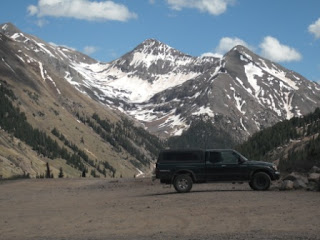So it goes with the Alpine Guard Station. We've been working on the three buildings for about 2 weeks now, and let me tell you, we've got a big mess. There's really no other way to do it. We've got foundation problems and rotten log problems, and plumbing problems...all things that require some demolition so that we can actually get to the problem. Let me remind you what the main cabin looked like before we began...

It's a great little building, complete with kitchen, bedroom and living room. Here's pictures of the inside two weeks ago:


Pretty cute huh? The kitchen has great little cabinet space, a sink with pressurized water, a nice stove, it even has a cool retro refrigerator. (Though there's a note in the kitchen stating that this fridge has been recalled and should not be used- I have no idea how very old that letter is.) The bedroom has cute little built in closets and a desk in between. Quite convenient. BUT, we had to figure out why the floor was sagging in the corners, and assess the stability of the foundation, as well as remove the rotten sill and spandrel logs. So here is what the inside of the cabin looks like now:



Demolition is fun, but it is kind of sad to see such destruction of such a great place. In Historic Preservation however, you gotta do what you gotta do. Let me state here that this kind of demo is not recommended! In HP you want to save as much of the original fabric as possible, and do as little alteration to the building as possible. In this situation however, we didn't have much choice. We had to get those rotten logs out, and we had to get to the foundation- sometimes you have to take drastic measures. I might also add that this is a 'Rehabilitation' project; meaning that we are changing the building slightly so that it can be a functional building for people to enjoy (rather than a true fundamental 'Preservation' project).
Cutting into the floors wasn't much of a challenge. Removing the sill log however, was. This is one heavy sucker of a building. Usually you use a couple of bottle jacks and the building will go right up, we had to get creative with this one, and we used lots of jacks. Here's Helaman attempting to jack up on corner:

We finally did get the building up, and then we were able to remove the sill log. It didn't come out as easily as we'd hoped, we wanted to save as much of it as possible, but the whole thing turned out to be pretty rotten. That's what happens when it's sitting on a concave slab of concrete for many years and water has it's way. We ended up having to cut it up in pieces with a chainsaw to get it out. But get it out we did. And here's how it looks now from both the inside and the outside:


Ah, now we've got some serious work to do! Now that we've made one enormous mess, we have to put it all back together. I'm really excited about this though. It's going to be really neat to see how it all comes together. We'll be able to work much quicker now that we've got the major problems out of the way, and we can start to really make the place look nice. Stay tuned!






.JPG)
.JPG)























